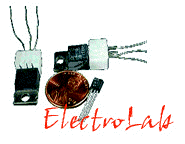






![]()
Today, in fact, right now, thousands of devices or appliances are being made or invented. Unless your parents or yourself work in an electronics factory, we are normally unaware of these things. The fact is, our everyday surroundings, for most of us lucky ones, are mostly electronic. And if anything you should have learned from this site, it is that electronic devices contain thousands, if not millions of transistors.
In fact, to explain the extent to which transistors extend in our lives, provided at the bottom of the page is a list of different devices or appliances that are found in our everyday lives.
 The first commercial application of transistors was
telephone equipment, which was made reality in the 1950's. These consisted of rural telephone carrier amplifiers and headset amplifiers for operators. The
transistorized hearing aid was developed by Alexander Graham Bell, who fought a life-long
struggle to help the hearing-impaired.
The first commercial application of transistors was
telephone equipment, which was made reality in the 1950's. These consisted of rural telephone carrier amplifiers and headset amplifiers for operators. The
transistorized hearing aid was developed by Alexander Graham Bell, who fought a life-long
struggle to help the hearing-impaired.
1954 was the year the transistor became popular culture, with transistorized radios coming out in that year. It was also instrumental in devices such as TV’s, portable radios, radars, computers, clocks and cameras. It was also this year that IBM announced that they would no longer be using vacuum tubes in their computers and released the first fully transistorized computer onto the market. It had about 2,000 transistors in it.
 It was in 1961, actually, that the real big breakthrough
came in transistor technology. This was the invention of the integrated circuit. The
integrated circuit is a group of transistors and other manufacturable electronic
components arranged in a certain way on a silicon wafer, complete with wiring. This
invention revolutionised transistor technology and spurred on the evolution of the
Information Age. In fact, every major information age invention was made possible by the
development of the transistor. It has been an invisible technology that is part of nearly
every electronic device, ranging from car ignitions, to satellites, to Porsches and
networks.
It was in 1961, actually, that the real big breakthrough
came in transistor technology. This was the invention of the integrated circuit. The
integrated circuit is a group of transistors and other manufacturable electronic
components arranged in a certain way on a silicon wafer, complete with wiring. This
invention revolutionised transistor technology and spurred on the evolution of the
Information Age. In fact, every major information age invention was made possible by the
development of the transistor. It has been an invisible technology that is part of nearly
every electronic device, ranging from car ignitions, to satellites, to Porsches and
networks.
What this all means is that, in the place of the room you are sitting in, you would be sitting on a rock, holding a club and wearing a leopard skin. Okay, maybe that is an exaduration, but I’ll leave it up to your imagination to see where mankind would have progressed to were it not for the transistor.
Here is a very short list naming some of the devices or appliances affected or directly developed as a result of the invention of the transistor:
|
|